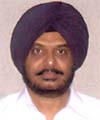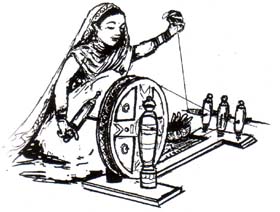The Lost Heritage: Punjab That No longer Exists
by: Dr Jaspal Singh
Date:17-07-06
Source: South Asia Post: Issue 19 Vol I, July 15, 2006
 Harkesh Singh Kehal, after his retirement from the Punjab Civil Service goes back to his village Sandaur in Sangrur district of Punjab to rediscover that vibrant pattern of life which he left behind a few decades before. The village has undergone a complete change almost beyond recognition, so Kehal has to reinvent it in his mind mainly depending on the reservoir of images tucked away in his subconscious. The result has not been disappointing at all as it blooms into half a dozen of books all demanding the attention of the reader interested in the folklore of Malwa. The latest Alop Ho Riha Punjabi Virsa (Lost Heritage of Punjab) appeared only a few weeks ago. This book dilates on fifty eight symbols and artefacts of Punjabi folk life and culture with a pencil sketch of each item so that one could have a palpable image of the object on his mentle screen.
Harkesh Singh Kehal, after his retirement from the Punjab Civil Service goes back to his village Sandaur in Sangrur district of Punjab to rediscover that vibrant pattern of life which he left behind a few decades before. The village has undergone a complete change almost beyond recognition, so Kehal has to reinvent it in his mind mainly depending on the reservoir of images tucked away in his subconscious. The result has not been disappointing at all as it blooms into half a dozen of books all demanding the attention of the reader interested in the folklore of Malwa. The latest Alop Ho Riha Punjabi Virsa (Lost Heritage of Punjab) appeared only a few weeks ago. This book dilates on fifty eight symbols and artefacts of Punjabi folk life and culture with a pencil sketch of each item so that one could have a palpable image of the object on his mentle screen.
The author writes about different kinds of wells, oxen, camels, thrashing frames, stacks of wheat and maize. Other farming instruments like wooden ploughs and harnesses find adequate mention. And then there are grinding stones and spinning wheels, milk churners and gins, carpets and cots, hand fans and pitchers, bullock carts and chariots, butter milk and jaggery, petticoats and pleated skirts, bangles and necklaces, crested turbans and seamless sheet trousers, lighted vessels and beating the winnowing trays, monsoon festivals and grain parching furnaces and so on.
 Almost half a century ago, the village well was one of the most charming places of the village when bouncy damsels would gather there with earthen and brass pitchers to draw water from the well. The village boys would also perch at a distance to have a glance of village beauties. Then with the passage of time, people installed their individual water pumps in their courtyards. The girls no longer visited the well which now wore a deserted look. A folksong expresses this feeling thus, “Khuhan tobian te milno reh gae/Chandre lwa lae nalkeâ€. (With the installation of cursed pumps, wells and ponds the favorite meeting places are deserted.)
Almost half a century ago, the village well was one of the most charming places of the village when bouncy damsels would gather there with earthen and brass pitchers to draw water from the well. The village boys would also perch at a distance to have a glance of village beauties. Then with the passage of time, people installed their individual water pumps in their courtyards. The girls no longer visited the well which now wore a deserted look. A folksong expresses this feeling thus, “Khuhan tobian te milno reh gae/Chandre lwa lae nalkeâ€. (With the installation of cursed pumps, wells and ponds the favorite meeting places are deserted.)
Same is the fate of spinning wheel, a very great cultural artefact of Punjab in the days of yore. Dozens of village women, young and old would sit at a common place with their wheels and spin for hours while singing and crooning lovely songs and sometimes cracking naughty jokes. In the night the spinning session (trinjan) would go on till midnight in somebody’s house. A folksong goes like this, “Jogi utar paharhon ae, charkhe di ghook sun keâ€. (Even the hermits descended from the hills at the sound of spinning wheel.)
 Fifty years ago there were no mettled roads in Punjab villages. Most of the marriage parties would go in a procession on bullock carts, chariots, horses and camels. Chariot was considered the most dignified of these means of transport. The bridegroom and his closest relatives and friends would drive the chariots. Others would take to other means. In a folksong there is a dig at the girl who broke the side bar of the chariot while mounting it in excitement of her marriage.
Fifty years ago there were no mettled roads in Punjab villages. Most of the marriage parties would go in a procession on bullock carts, chariots, horses and camels. Chariot was considered the most dignified of these means of transport. The bridegroom and his closest relatives and friends would drive the chariots. Others would take to other means. In a folksong there is a dig at the girl who broke the side bar of the chariot while mounting it in excitement of her marriage.
Among the old female dresses the pleated skirt (ghaggra) had pride of place. Whenever a married woman ventured outside the house, she would invariably put on the heavy skirt which was made of ten to fifteen yards of cloth. The newly wed women would wear silken skirts and they looked so suave and elegant while moving in a graceful manner with aplomb. A very popular Punjabi song sings praises of the damsel wearing a skirt made of twenty yards of silk. She would sway her beautiful waist while moving in a style.
The male variant of the skirt (ghaggra) is the seamless sheet trouser (chadra). The young men wore it around the waist hanging it down up to the ankles. It could be made of cotton or silk measuring two and half yards double breadth. On festivals and fairs the young men would put on beautiful sheets and go in bunches singing folksongs.
 Whenever there was marriage the girls would take out a procession with a lighted vessel called Jago. A winnowing tray made of reed was also beaten as a ritual with singing dancing accompanying it.
Whenever there was marriage the girls would take out a procession with a lighted vessel called Jago. A winnowing tray made of reed was also beaten as a ritual with singing dancing accompanying it.
Just like the well, there was another meeting place of the youth in the village. It was the grain parching furnace (bhatthi) where the girls used to go far roasting grains of gram or maize. The boys would also hover around to exchange a look or a smile. For baking loaves of bread there was community earthen oven (tandoor) where many women would descend to bake the chapattis. This lent a communitarian aspect to the village life. But in small villages this kind of community oven was not very popular.
Harkesh Singh Kehal has extensively dwelt on many such ingredients of the rural life of Punjab which almost half a century ago was the indispensable part of people’s daily chores. Entire warp woof of life was woven around these artefacts. But the sweeping changes of the recent years have swept away all the remnants of these objects and symbols. The author fondly remembers them and has tried to make a repertoire for future reference. Apart from this the entire collection makes a sensitive discourse of nostalgia which the old generation sentimentally harbours even today.